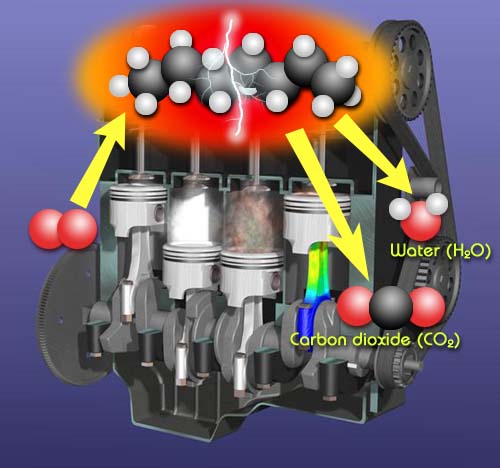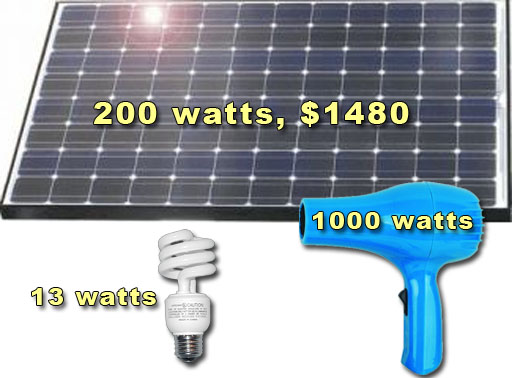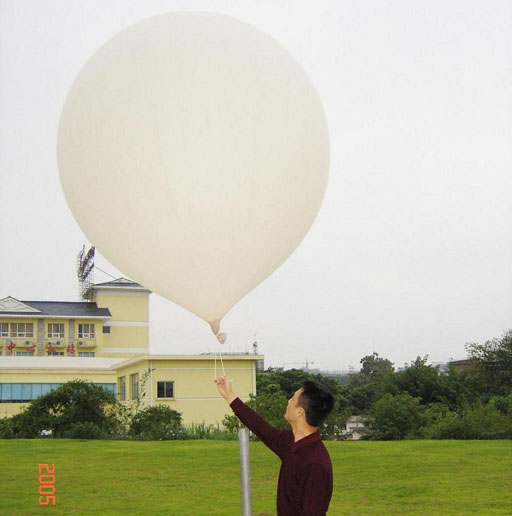PROBLEMS
The problems were taken from the 6th, 7th, and 8th editions. You don't have to find them in your textbook because I've reproduced them below. Most problems are my own just to spice it up.
|
|
Problem 1: A balloon filled with 39.1 mol helium has a volume of 876 L at 0.0°C and 1.00 atm pressure. The temperature of the balloon is increased to 38.0°C as it expanded to a volume of 998 L, the pressure remaining constant. Calculate q, w, and ΔE for the helium in the balloon. (The molar heat capacity of helium gas is 20.8 J/°C·mol)
My notes: To start off at 0.0°C, the balloon must have been stored in big freezer. Then brought outside on a 100°F (38.0°C) day. The hot air around the balloon warmed the helium and caused the balloon to expand. The energy it received from warming is q (heat energy). So helium's internal energy (ΔE) will go up. Because the balloon stretches, the balloon pushes on the atmosphere as it expanded. That means work (w) was being done. So some of that heat energy was used to push away the atmosphere (do some work). So that gets subtracted from the internal energy. See below spreadsheet.
|
Work is force x distance, but for gases, an alternative is Pressure x Volume change. The finds "w" or work. The molar heat capacity is used to find heat absorbed ("q"). Molar heat capacity is like specific heat, except instead energy "per gram" it is energy "per mole".
| |
A |
B |
C |
D |
E |
F |
G |
H |
I |
| 1 |
Temperature rise |
molar heat capacity |
Moles of helium in balloon |
|
This is "q" and it will be added because energy was taken in by helium |
| 2 |
38.0 |
°C |
20.8 |
J |
39.1 |
moles helium |
= |
??? |
Joules heat absorbed (gained) (+q) |
| 3 |
|
|
|
°C·mol |
|
|
|
|
|
| 4 |
|
| 5 |
Pressure in & on balloon |
x final volume minus start volume |
Conversion of atm·L to Joules |
|
This is work done by helium (w) and is subtracted because energy left helium |
| 6 |
1.00 |
atm |
=998-876 |
volume change in Liters |
101.3 |
Joules |
= |
??? |
Joules of work done by helium gas (-w) |
| 7 |
|
|
|
|
1 |
atm·L |
|
|
|
| 8 |
|
=H2-H6 |
ΔE = q - w [change in internal energy in Joules] |
|
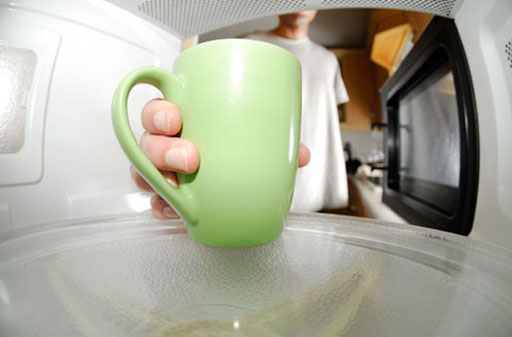 |
A cup of water is placed in the microwave and zapped with 1,000 watts of microwaves. If the water and cup started at room temperature (70°F), it would be nice to know how long will it take until the water starts to boil. It's a good assumption that all energy goes into the water and cup. The empty cup weighs 450 grams and has a specific heat of glass, which is 0.21 cal/°C·g. There was 225 mL of water in the cup. That's 225 grams of water.
This problem is tougher than normal specific heat problems because time is involved plus there are two materials (water and cup) that are heating up. I just made up the problem and really don't know how to solve it. But I know the dimensions will guide me.
Normally glass with a smaller specific heat will heat up faster than water, but a microwave is tuned to heat water not glass, so the water will heat up faster, but the hot water will quickly heat up the glass. So I think it's safe to say they will heat up basically as the same rate. In that case we can treat them as just one material. We just need to combine their masses and specific heats. |
If we multiply water's mass times its specific heat, we see that it takes 225 calories per °C. Doing the same with the cup, we see it takes 94.5 calories per °C. By adding them we get the total calories needed for each degree. Note: I normally convert watts by using 1 watt=1 joule/sec, but its better here to use 1joule=1watt·second (This means 1 watt going for 1 second)
| |
A |
B |
C |
D |
E |
F |
G |
H |
I |
J |
K |
L |
M |
N |
| 1 |
water |
225 |
g |
1 |
cal |
= |
225 |
calories |
|
|
|
|
|
|
| 2 |
|
|
|
|
°C · g |
|
|
°C |
|
|
|
|
|
|
| 3 |
cup |
450 |
g |
0.21 |
cal |
= |
94.5 |
calories |
|
|
|
|
|
|
| 4 |
|
|
|
|
°C · g |
|
|
°C |
|
|
|
|
|
|
| 5 |
|
|
|
|
Add both |
319.5 |
calories per °C for both |
|
|
|
|
|
|
| 6 |
|
|
|
Degrees to get to boiling
°C=(70°F-32)*5/9=21.1
100°C-21.1°C=78.9°C |
|
|
|
|
|
|
|
|
|
| 7 |
|
Value from G5 |
To the left calculates calories. To cancel calories in C8, I had to divide by 1000 watts so that calories in K9 would end up in denominator. |
|
sec to go to boiling |
| 8 |
cup&water |
319.5 |
calories |
78.9 |
°C |
|
|
1 |
watt · second |
4.18 |
joules |
= |
???? |
seconds |
| 9 |
|
|
°C |
|
|
1000 |
watts |
1 |
joule |
1 |
calorie |
|
|
|
| 10 |
Shorter conversion |
I looked up this conversion to cancel calories in 1 step |
|
|
|
| 11 |
cup&water |
319.5 |
calories |
78.9 |
°C |
|
|
4.18 |
watt · second |
= |
???? |
seconds |
|
|
| 12 |
|
|
°C |
|
|
1000 |
watts |
1 |
calories |
|
|
|
|
|
Problem 2: How many seconds does it take for the cup and water to get up to 100°C?
Problem 3: The problem gave the information of 1000 watts of power. Why did I divide by 1000 watts (F9/G9) rather than multiply by 1000 watts?
Problem 4: If there were 325 mL of water instead of 225 mL, what would be the value shown in B8?
Problem 5: If a paper cup was used instead and it weighed 20 grams and had a specific heat of 0.33 cal/°C · g, what cells above would need new values typed in?
A spreadsheet like this one could be used in restaurants where waiters or chefs can put in the weight and desired final temperature, then the spreadsheet could then tell them how many seconds to set the microwave.
|
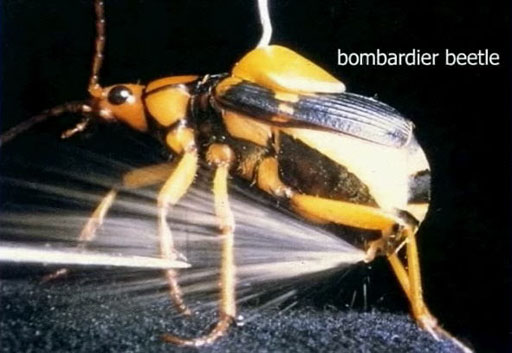 |
A bombardier beetle produces and stores two reactant chemical compounds, hydroquinone and hydrogen-peroxide in separate reservoirs in the rear tip of its abdomen. When threatened, the beetle contracts muscles that force the two reactants through valved tubes into a mixing chamber containing water and a mixture of catalytic enzymes. When combined, the reactants undergo a violent exothermic chemical reaction raising the temperature to near the boiling point of water. The corresponding pressure buildup forces the entrance valves from the reactant storage chambers to close, thus protecting the beetle's internal organs. The boiling, foul-smelling liquid partially becomes a gas (flash evaporation) and is expelled through an outlet valve into the atmosphere with a loud popping sound.
(Above description from Wikipedia). The below info is from textbook:
The chemical reaction involved is :
C6H4(OH)2(aq) + H2O2(aq) --> C6H4O2(aq) + 2H2O(l)
Problem 6: Calculate ΔH for this reaction from the following data: |
| |
A |
B |
C |
D |
E |
F |
| 1 |
C6H4(OH)2(aq) |
--> |
C6H4O2(aq) + H2(g) |
ΔH= |
+177.5 |
kJ |
| 2 |
H2(g) + O2(g) |
--> |
H2O2(aq) |
ΔH= |
-191.2 |
kJ |
| 3 |
H2(g) + ½O2(g) |
--> |
H2O(g) |
ΔH= |
-241.8 |
kJ |
| 4 |
H2O(g) |
--> |
H2O(l) |
ΔH= |
-43.8 |
kJ |
| 5 |
Below is the target reaction. Some of the above will need reversed so that you end up with target reaction. Some may need doubled. |
|
|
|
| 6 |
C6H4(OH)2(aq) +H2O2(aq) |
--> |
C6H4O2(aq) + 2H2O(l) |
ΔH= |
??? |
kJ |
|
| I also read that some of the hydrogen peroxide was broken down by enzymes to make water and oxygen gas, which created extra pressure. The gland that shoots the liquid can swivel 3/4 of a circle so it can be aimed from side to side. Hydroquinone has been used to whiten human skin and used in photography to turn siliver chloride into metallic silver. There's also a flower that contains hydroquinone and will cause rashes on people who brush up against it. |
| Send your answers to CHM151@chemistryland.com. Use Subject title of "Chapter 6". |
